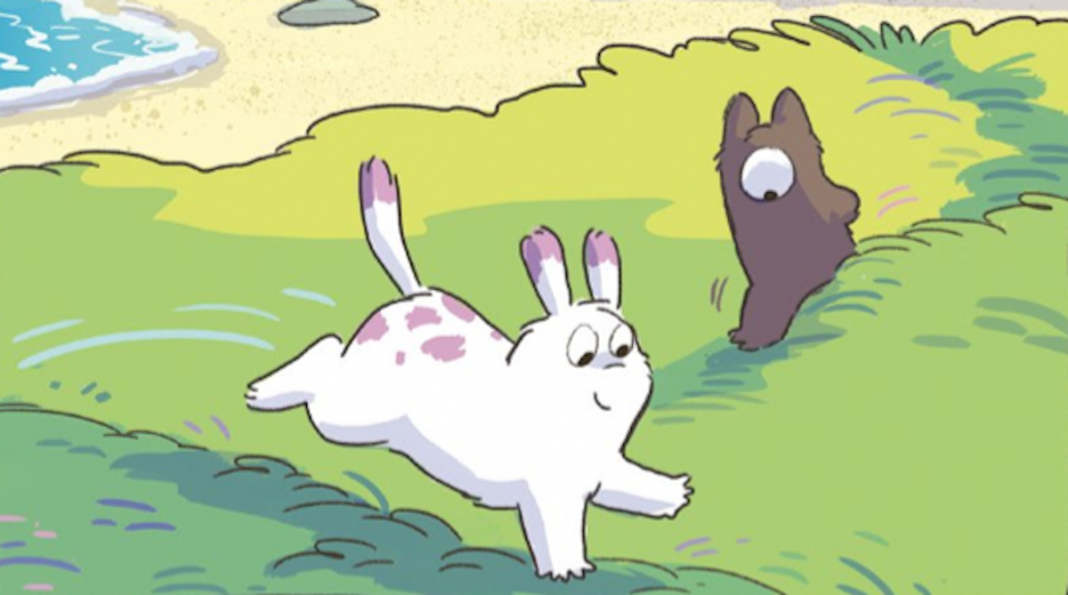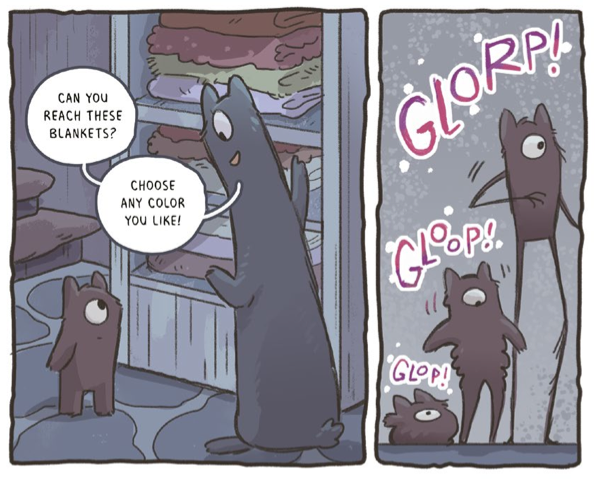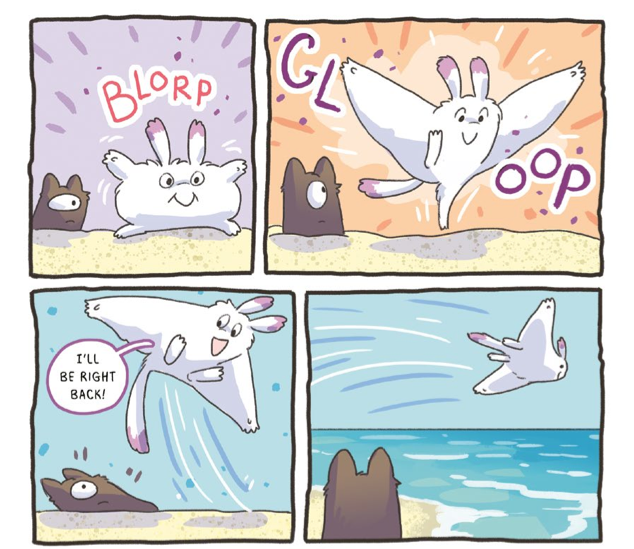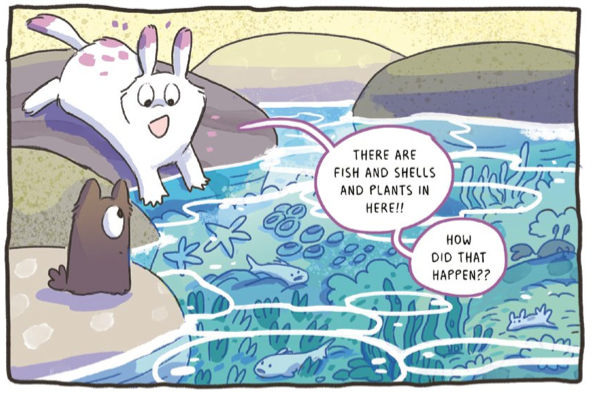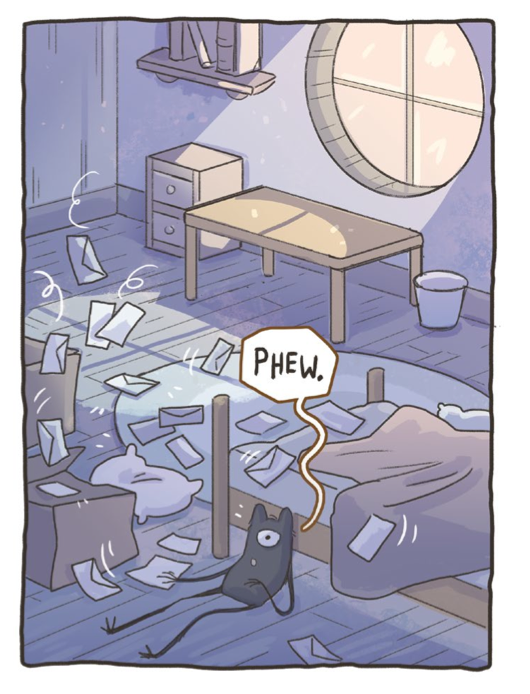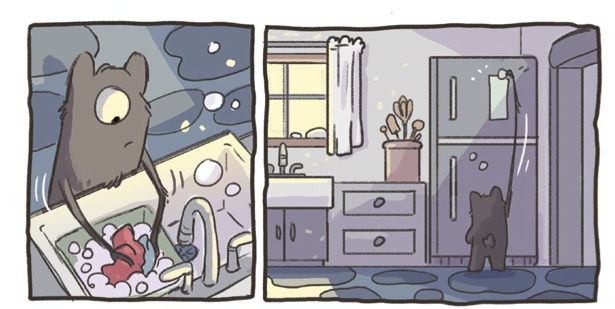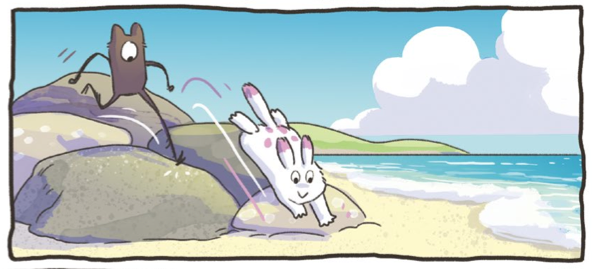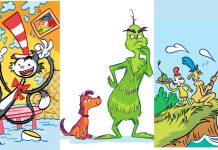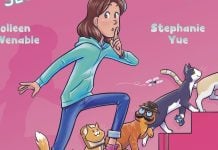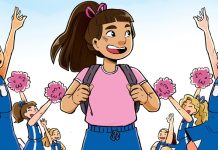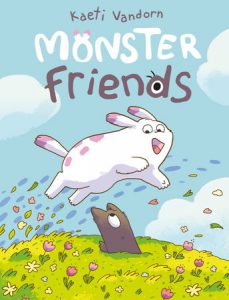
The Beat caught up with Vandorn over email and found out more about arriving at Reggie’s unique shape, what it was like to develop a graphic novel out of a webcomic, and what went into contributing to RH Graphic’s stellar launch-year line-up!
AVERY KAPLAN: One thing I really adore is the way Reggie’s body moves and changes shape. Can you tell us a little bit about when this aspect of Reggie’s character emerged, and what went into designing such a unique, shape-shifting protagonist?
KAETI VANDORN: This is something that happened very very early in Reggie’s character development – even before I knew what “shapeshifter” meant! Before Reggie had a story, he mostly served to fill space on a page; be that the margins of homework, or spare corners of a sketchbook. Although he did change shape often, certain things about Reggie’s design always stayed consistent: he was a black/dark colored splotch; he nearly always had two pointy ears; and he only ever had one eye. I’m not sure exactly when I began using his shape as an extension of expression? But it’s something that has grown into a fundamental part of his personality, and I almost can’t imagine him without that feature now.
The monsters in my stories can act more human and more animal depending on which expression most suits the situation. There are times in the story where Reggie feels a little wild, and in those moments, he tends to run on four legs and act more like a little animal. There are also instances when he doesn’t have any legs and just moves around as this little squishy shape; I imagine these times are when he’s the most unsure – it’s the equivalent of sticking your hands in your pockets to keep from fidgeting. Beyond that, there’s no real rules to when he becomes one thing or another – it simply depends on which is the more emotive option!
KAPLAN: Was it important that both Reggie and Emily could change shape?
VANDORN: I think so! There was a moment in early development where I thought Emily was a rabbit that Reggie was friends with. As the story morphed into its current form, I came to see that Reggie needed another monster friend to encourage him to change shape … because he wasn’t going to change much on his own, otherwise! Emily is things Reggie is not; she is bright, cheerful, inquisitive, a little immature at times … More or less different than how Reggie chooses to present himself during this story. This difference comes out in the way they both shapeshift, too. Reggie is careful to use his shapes very practically in MONSTER FRIENDS. He will glop to get at something out of reach; gloop himself a pair of wings to fly; and glorp himself away from something he doesn’t want to deal with. Emily isn’t so burdened by this, and changes shape mostly as a means of play.
A big cloud!! ⛅️⛅️⛅️ pic.twitter.com/hC3wroEUzI
— Kaeti V. (@proteidaes) July 14, 2021
KAPLAN: One of my favorite aspects of Monster Friends is its depiction of the characters as they struggle with their emotions, especially anxiety, and how they navigate the same. Could you elaborate on this theme, and why it was important to include in Monster Friends?
VANDORN: I cannot tell you the amount of feedback I’ve had in this area, and I’m so happy this emotional awareness comes through! I attribute this to the time and place that I wrote Call of the Sentinel – the webcomic I adapted into MONSTER FRIENDS. I was feeling very overwhelmed about school, work, and home at the time … and Reggie’s story became an extension of my desires to drop everything and recharge. Of course, I couldn’t literally burrow underground, but I let Reggie do it! I gave him this moment where he got to run away from his problems, and that outlet gave me a little boost during the next several years – and also a really strong portfolio piece to work from! This is just one of the many ways I have found comfort in my art, and I still use drawing to unpack difficult concepts. Putting an anxious thought on paper lets me step outside my head for a bit; and drawing or painting can turn problems into beautiful things to share with others.
KAPLAN: Monster Friends was developed from your webcomic Call of the Sentinel. Can you tell us about what it was like to adapt your webcomic into a graphic novel?
VANDORN: It was certainly a surreal experience! We very rarely get “two shots” to do anything in life, but here I am, sitting on two very different takes of what is essentially the same story! I did write CotS with the intent of making a printed book of some kind in the future … but I think I always knew the full story could only ever exist digitally. Print books don’t really have the luxury to spend hundreds of pages on one or two narrative beats. That unhurried length became an essential part of CotS, and one that was an interesting task to transpose within a limit of panels and pages. All that said, I do think MONSTER FRIENDS preserved a lot of the essence of CotS, and I’m happy to have both in my portfolio.
Layout was probably the hardest thing to change as I was updating the story for print. RHG specifically requested I adhere to square or rectangular panels and then 4-6 panels per page for ease of reading … which is not something I spent much thought on while making CotS! Sometimes that meant I had to smush or stretch scenes to get them to read right. The original comic was also presented in a square page format, so I could show off these huge sweeping landscapes in double-page spreads. Some of that made it into MONSTER FRIENDS, though I do miss the extra wide layout sometimes.
KAPLAN: Another aspect of this story that I really loved was the exposition, and how it is handled through glimpses of Reggie’s mail. When did you arrive at this narrative technique?
VANDORN: One thing I determined very early for both MONSTER FRIENDS and CotS was that Reggie’s world does not have much modern technology. There are telephones here and there, but the primary form of remote contact is snail mail. Reggie’s letters serve a special purpose in that they let us glimpse his recent past without leaving the frame of the current storyline. Reggie has this whole life beyond the pages, where he’s gone on adventures with some very colorful friends. He does eventually talk about that, but all this unanswered mail shows there’s a lot going on for him, and that he’s taking his time to process everything. Letters are a very special way to track time and events, and they just provided such a neat package to tie all this together in a page or two.
KAPLAN: Was there any aspect of making Monster Friends into a graphic novel that posed a particular challenge? How did it compare with the process for your previous graphic novel, Crabapple Trouble?
VANDORN: Both these books shared a challenge that I think a lot of first-time authors encounter: a tight deadline!! In order to contribute to RHG’s launch year, I needed to finish my books in about 9 months each… which I now know is a monumental task, and I won’t be attempting again any time soon! I do think this was made easier because so much of the material was written and approved beforehand. I did have to juggle the story for CRABAPPLE a little bit, but MONSTER FRIENDS already had a strong style and voice, and the script was approved very quickly. It was mostly a matter of logistics. I pared down my workflow to be as efficient as possible so that I could bring these stories to life in a thoughtful way within the allotted time. Overall I’m quite happy with the results! But I’m definitely looking forward to a slower pace in my future projects.
KAPLAN: Is there any comic (or any other kind of story) that has been inspirational for you lately?
VANDORN: There are so many amazing comics and books I have enjoyed reading this summer, but two series I have recently found really stand out: Aron Nels Steinke’s Mr. Wolf’s Class and Dana Simpson’s Phoebe and her Unicorn. They are both so charming and full of playground antics! I was homeschooled all the way through high school, and even took much of my college education through correspondence … so while classroom stories are relatable to most people, it is a new and interesting world to me.
I have also enjoyed a handful of classic fantasy/sci-fi series from my ever growing to-be-read list: Andrzej Sapkowski’s The Witcher; C.J. Cherryh’s Chanur novels; Frank Herbert’s Dune saga; and the Ursula K. Le Guin’s Earthsea Cycle … All such wonderful and inspiring books!
Also, if you care to know: Reggie’s story has a long list of material that inspired its development: Winsor McKay’s Little Nemo in Slumberland; Archie Comics’ Sonic the Hedgehog series; Jeff Smith’s Bone; Bill Watterson’s Calvin and Hobbes; Tove Jansson’s Moomin novels; Beatrix Potter‘s Peter Rabbit stories; Jill Barklem’s Brambly Hedge; A.A. Milne’s Winnie-the-Pooh novels; and Michael Bond’s Paddington Bear series. I still have many “funny animal” stories yet to explore, but the genre is so rich and engaging … I just love the motif of using creatures and animals to tell very human stories. It’s really my favorite thing!!
Monster Friends is available at your local book store and public library today!


